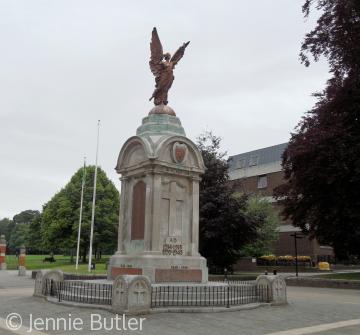Basingstoke War Memorial

The 233 names on the town memorial represent only a small proportion of Basingstoke men who died serving in the First World War. It is believed that 600 is nearer to the total number of men lost. They are listed only by surname and initial. By using websites, record offices, church memorials and other local sources a more detailed identification of the men has been made. Inevitably some records are ambiguous and others are missing but work will continue to try and complete the information. The spreadsheet below is the work to date. By identifying home addresses a pattern emerges of streets where several fathers and sons were lost and family groups who not only lost serving men but also husbands and wives still at home. The impact on individual families and the town itself is hard to appreciate.
The idea of a memorial was first discussed on 28th January 1919 when a public meeting at the Town Hall unanimously resolved that a War Memorial for Basingstoke should be erected. A meeting in the following May agreed that Goldings – a Georgian house situated within five minutes from the town centre – should be purchased along with its 15 a. well timbered park. Thomas Burberry put up the sum of £10,500 to acquire the house and grounds until the Council were able to raise sufficient funds, mainly by subscription. By 1921 the £4,500 loan for the park was repaid and two years later an additional £2,000 enabled the newly commissioned War Memorial to be unveiled on Empire Day, the 24th May 1923, in front of Goldings House which had by then been acquired by the Council for municipal purposes.
The Memorial is of Portland stone standing on a circular platform four steps above ground level. Three of the four faces display bronze tablets with the names of 233 men who died serving their country in the First World War. The fourth side was initially inscribed with ‘In Memoriam A.D. 1914-1918’ with a stone cross and the arms of the Borough. On top of the column is a winged bronze figure of Victory shown alighting to place a laurel wreath in memory of the fallen. This was donated anonymously by four subscribers and was cast by L.F. Roslyn. The stonework for the monument was erected by Messrs Mussellwhite & Son of Basingstoke. The total cost of the gates, monument and park represented a substantial fund raising effort by the inhabitants of the town. Names of those who died in the Second World War have been added on separate plaques.
The website www.holyghostcemetery-basingstoke.org.uk has information and guides relating to the CWGC graves in their cemetery.
Content derived during research for the new VCH Hampshire volume, Basingstoke and its surroundings.


